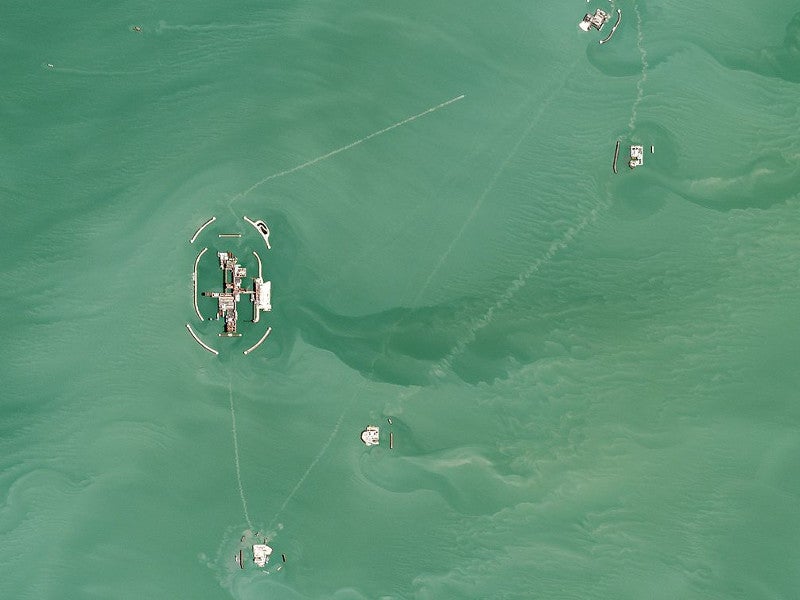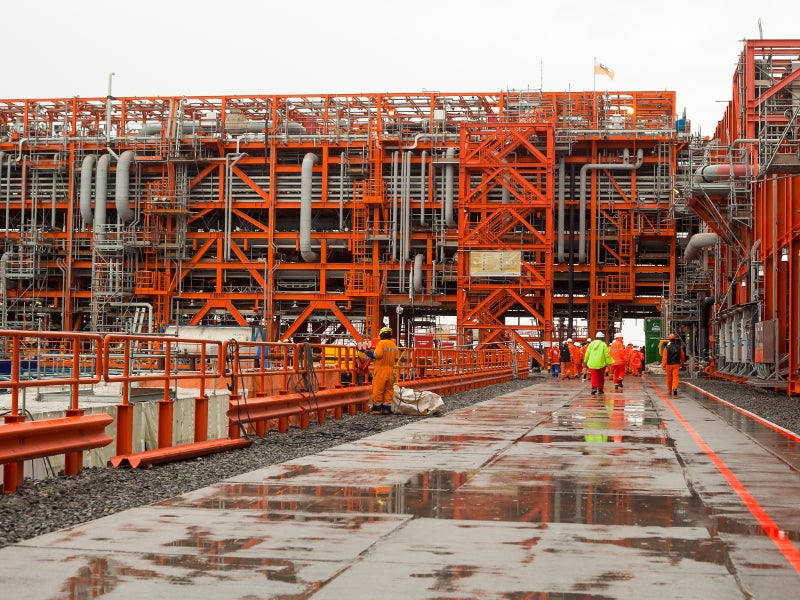Kashagan is a massive shallow-water oil field located approximately 80km offshore Atyrau, Kazakhstan, in the North Caspian Sea. Kashagan phase one is the first offshore oil field development project in Kazakhstan, which commenced commercial production in October 2016.
The Kashagan field is being developed and operated by North Caspian Operating Company (NCOC), a joint venture of the state-owned KazMunaiGas (KMG, 16.9%), Shell (16.8%), Total (16.8%), Eni (16.8%), ExxonMobil (16.8%), CNPC (8.3%), and Inpex (7.6%). NCOC is the operating company for the North Caspian Sea Production Sharing Agreement (NCSPSA).
Developed with an estimated investment of £45bn ($55bn), Kashagan phase one represents the biggest international investment in Kazakhstan till date. Developed in harsh offshore environment, it is also considered to be one of the world’s most technically challenging oil and gas project completed so far.
Kashagan phase one, which is also known as the Experimental Program (EP), reached its maximum design capacity of 380,000 barrels per day (bopd) in the first half of 2019.
The offshore field is planned to be developed further in subsequent phases as part of the Full Field Development Programme that can raise the field’s output up to 1.5 million barrels of oil a day (Mbopd).
Kashagan discovery and reservoir details
Located in water depths between 3m and 4m, the Kashagan oil field was discovered by the Kashagan East-1 discovery well in June 2000.
The Kashagan discovery was declared commercial in June 2002, following the drilling of Kashagan West-1 exploration well and the Kashagan East-2 appraisal well in 2001.
Four smaller oil fields namely Kalamkas-Sea, Kairan, Aktoty, and Kashagan South West were also discovered in the NCSPA license block between 2002 and 2003.
Kashagan is considered to be one of the world’s biggest oil discoveries in 45 years. Measuring 75km-long and 45km-wide, the shallow-water field covers 2,678km² in the Caspian Sea.
Located 4.2km beneath the seabed, the highly-pressurised Kashagan reservoir is estimated to contain more than 35 billion barrels of oil, out of which up to 13 billion barrels are recoverable.
The hydrocarbon fluids accumulated in the Kashagan reservoirs bear high concentration of hydrogen sulphide.
Kashagan phase one development details
The construction of D Island, the biggest among all artificial islands built on the Kashagan field so far, was started in November 2002, while drilling activities from this island were started in July 2006.
Construction of the onshore processing facility at Bolashak was started after the Republic of Kazakhstan Government approved the Kashagan development plan in 2004, while most of the onshore and offshore installation works were performed between 2006 and 2008.
Offshore hook-up works were carried out in 2010 and two raw gas injection modules were installed on the D Island in June 2012.
Although initial production from the Kashagan field was started in September 2013, it had to be suspended due to gas leakage and defects in onshore section of the gas pipeline originating from the field.
Production from the offshore field was restarted after the completion of the pipeline rehabilitation project in September 2016. The Kashagan oil and gas field was officially declared operational in November 2016.
Kashagan phase one infrastructure facilities
The Kashagan field has been developed with a total of 40 wells and five artificial islands including two large islands, namely A and D, and three smaller islands namely, EPC 1, 2, and 3.
Kashagan phase one includes 40 wells, comprising 20 wells operated from A and D Islands and the remaining 20 from the EPC islands.
Connected with all other offshore bases, the D Island serves as the offshore processing and production hub for the field.
The produced hydrocarbon fluids are processed for oil and gas separation at the D Island. Half of the gas produced is re-injected into the reservoir, while the remaining gas and crude oil are piped onshore to the Bolashak plant for final processing. Kashagan phase one involved a total pipeline network of 510km.
The bulk of crude oil processed at the Bolashak facility is fed into the Caspian Pipeline Consortium (CPC) pipeline system, the key export network for Kazakhi crude that runs from the Tengiz onshore oil field along the Caspian shore to the Novorossiisk Port on Russian Black Sea.
The sour gas is stripped of hydrogen sulphide and some of the produced sweet gas is used for onshore and offshore power generation. The remainder is marketed as Sales Gas, which is delivered through a dedicated pipeline to Makat and further via the KazTransGas pipeline network.
Sulphur produced at the facility is exported by rail through a dedicated rail loading facility at Eskene West.
Production from Kashagan
The Kashagan phase one development achieved 180,000bopd production capacity in early-2017 and 200,000bopd by mid-2017.
The phase one design capacity was further increased to 380,000bopd in 2019. NCOC believes the capacity can be furthermore increased by 100,000bopd through additional production drilling and process optimisation.
The field produced a cumulative total of 30 million tonnes of crude oil, more than 8.44 billion cubic meters (bcm) of gas, and 1.75 million tonnes (Mt) of sulphur as of August 2019.
NCOC plans to increase the field’s output to 420,000bopd by 2022 and 500,000bopd by 2027.
Kashagan full field development plan
The Kashagan field development is planned to progress from the eastern and central parts of the field towards the western end.
The full field development plan includes a total of 35 drilling centres, two offshore processing hubs, three offshore gas plants, a large-scale onshore processing facility with multiple oil trains and gas sweetening plants, approximately 1,000km of infield pipelines, umbilicals, and power cables, and 500km of trunk lines.
Major contractors involved
ERSAI Caspian Contractor, a subsidiary of Saipem, was awarded a £1.17bn ($1.8bn) contract for the construction of two 95km pipelines connecting the D island of the Kashagan field with the Karabatan onshore plant, in February 2015.
Saipem along with Aker Solutions was awarded a £1.67bn ($2.6bn) contract for the installation and commissioning offshore production facilities as well as the infield production lines and trunk lines for the project in May 2009.
Saipem was also engaged for the review and development of the Pre-FEED study, detailed design, and onshore survey for the project from 2005 to 2006.
KBR provided project management services for the Kashagan phase one as well as provided conceptual design for phases two and three.
McDermont provided FEED for the Kashagan full field development plan, while WorleyParsons, in a joint venture with CB&I and Aker Solutions, was awarded an updated FEED services contract for phase two development of the field in April 2010.
North Caspian Constructors (NCC), a joint venture of Fluor, Tekfen Construction, and Gama Group was contracted for the management of onshore construction works in October 2005.
Bateman Litwin was responsible for the engineering, procurement, and construction (EPC) of the 270MW power station and the utilities plant at Eskene West.
The Boskalis-Archirodon joint venture was contracted for the construction of rock islands on the field in 2003.
ENKA along with its Kazakh partner MSS was also engaged for offshore civil construction works for the project. The latest contract awarded to the joint venture in May 2016 was for site preparation as well as hook-up, mechanical completion, and commissioning of topsides for EPC Island 3. ENKA was also involved in the Pipeline Replacement Project that was implemented between 2015 and 2016.
Another major construction company engaged in the project was the Middle East-based Consolidated Contractors Company (CCC).
Rosetti Marino was engaged for fabrication, testing, and hook-up works for the processing hub at D Island, while Skema was the EPC contractor for offshore utilities buildings for Island D.
Other contractors involved in Kashagan oil field development
Renco designed, delivered and commissioned local equipment on EPC2 and EPC3 islands, while TRILLINI Engineering provided project management and engineering services.
Keppel Offshore and Marine was contracted for 19 jack-ups, three semisubmersibles, a tender rig along with barges, as well as pipe racks for the Kashagan field development in 2005.
ABB provided a self-contained power generation barge for the project under a contract awarded in September 2004, while Consafe McNulty joint venture provided accommodation barges and SBM Offshore provided Compression barges.
Kitek Construction was engaged for the installation, maintenance, and pre-commissioning of power distribution systems and power facilities for the project.
Synectics Industrial Systems provided IP networked CCTV system for the project.
KazStroyService and Punj Lloyd were engaged for the construction of oil and gas export pipelines for the project.
The sour gas reinjection trains for the project were provided by GE Oil & Gas.
KTR-WG Turbine Services, a joint venture between Wood Group and KazTurboRemont (KTR), was awarded a long-term contract to provide maintenance services for the turbines and compressors being used for the project.
The turbines and compressors for the project were provided by GE, Siemens, and Rolls-Royce.





